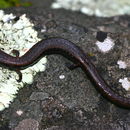Description
provided by AmphibiaWeb articles
This is a small (to about 45 mm snout-vent length; 110 mm total length), slender species with a relatively broad head but only a weakly developed neck. Tails are long and slender, usually much longer than the head + body. Limbs are moderately long for a member of this genus, but from 7 to 8.5 costal folds are uncovered when the limbs are appresed to the trunk. There are 18-19 costal grooves in males and 19-20 in females. As is typical for members of this genus, the digits are small, but well formed, and there are only four digits on the hind limbs. These are blackish animals that have a lighter, brownish, dorsal band that varies from tan to light brown and is streaked or flecked with darkerpigment. The ventral surfaces are pale gray, and there are abundant tiny white spots on the lateral and ventrolateral surfaces, extending onto the venter.Until recently this species was confused with the widespread congener Batrachoseps attenuatus, which it closely resembles in morphology (this species generally has a wider head and longer limbs). See another account at californiaherps.com (http://www.californiaherps.com/salamanders/pages/b.diabolicus.html).
Distribution and Habitat
provided by AmphibiaWeb articles
This species occurs along the eastern margins of the Central Valley of California, below the foothills of the Sierra Nevada, from the American River in the north to south of the Merced River. The species probably extends to elevations around 1,000 m, but in general it occurs at low elevations in open, brushy areas, dominated by chaparral but usually only scattered deciduous and live oak and gray pine trees. It occurs at elevations between about 75 and 200 m.
Life History, Abundance, Activity, and Special Behaviors
provided by AmphibiaWeb articles
Although this species is locally abundant, little is known concerning its ecology or life history. It occurs in areas that are intensely hot during the long (usually 6 month), dry summers. Rainfall in this region ranges between 50 and 80 cm per year, and average daily termperatures exceed 27 C for 4.5 months. Accordingly, the species is active only during the moist winter and spring months, when it is found under rocks, logs, and surface litter.
Life History, Abundance, Activity, and Special Behaviors
provided by AmphibiaWeb articles
This species is fortunate to occur in areas that are not heavily used by humans, and so there appear to be few threats to its continued existence. The greatest threats are probably from cutting oak trees for firewood and charcoal, and from clearing brush land for cattle grazing.
Relation to Humans
provided by AmphibiaWeb articles
In general humans are unaware of the existence of this species, although it probably is encountered by ranchers and home owners in this generally sparsely settled region.
Hell Hollow slender salamander
provided by wikipedia EN
- license
- cc-by-sa-3.0
- copyright
- Wikipedia authors and editors
Hell Hollow slender salamander: Brief Summary
provided by wikipedia EN
The Hell Hollow slender salamander (Batrachoseps diabolicus) is a species of salamander in the family Plethodontidae. It is endemic to California, in Mariposa County in western United States.
- license
- cc-by-sa-3.0
- copyright
- Wikipedia authors and editors

